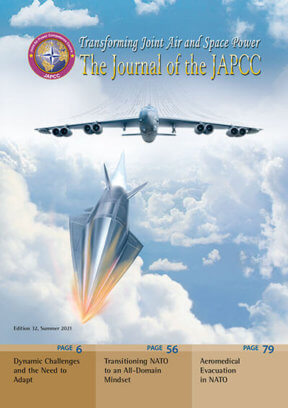Introduction
Space has recently been recognized by NATO1 as the fifth operational domain for military operations and guarantees fundamental services and applications for all Armed Forces, strongly influencing the success of modern military operations.
Main services provided by space platforms include satellite communications, Positioning, Navigation and Timing (PNT) systems, earth observation and Intelligence, Surveillance and Reconnaissance (ISR) applications, all of which ensure essential operational capabilities for Armed Forces. Even services that enable modern equipment, weapon systems and the planning of operations, represent an element of extreme vulnerability, whose temporary or permanent unavailability can lead to trans-versal repercussions across the entire spectrum of military actions.
As stated, space is now considered a physical domain on a par with sea, land, air and cyberspace but, unlike the first three, it is not heavily populated and, relatively speaking, not even trafficked. Therefore, it has previously been treated mostly as a mission, rather than a domain to occupy and protect. However, the situation is rapidly evolving.
The battlefield has been extended vertically and space is an integral part, since almost every soldier has space-enabled devices among his equipment. Currently, the Army uses space capabilities mostly to communicate, navigate, target the enemy and protect its forces. In the near future, it is probable that the Army will become even more dependent on space-based capabilities.
It is therefore evident that tomorrow’s soldiers will rely on the expanded use of space capabilities and these features will be essential for enabling all military activity.2 Furthermore, the integration of space data will enhance the ability to achieve information superiority and full battlespace awareness for full-spectrum dominance.
There will soon be a time when conventional warfare also occurs in the space and cyberspace domains. The Army would be negligent not to develop expertise to help manage these future conflicts and help control the outcomes. The topic of Multi-Domain Operations (MDO), which refers to the inclusion of the cyberspace and space domains with the conventional land, sea and air domains, has begun to energize the doctrinal discussion with allies producing some initial solutions. The advent of the MDO concept is dramatically changing the way the Army conducts operations and continues to be a subject of extreme interest.
The land component must be able to conduct operations that will see it constantly and simultaneously engaged across all five domains in order to overcome problems imposed by adversaries. Similarly to cyberspace, the space domain should therefore be exploited by all Commanders with a different level of penetration from tactical to operational.
It is essential that the Army is expeditionary and responsive to adequately support operations in multiple domains. Land component officers rely on the ability to rapidly and seamlessly integrate space capabilities into their operations, enabling convergence and cross-domain synergy to create multiple dilemmas for an adversary. The Army’s ability to employ cross-domain fires provides lethal and non-lethal options for commanders and overcomes enemy attempts at degrading or denying space effects.
Developing New Space Leaders
Within this scenario, the Army’s strategic role in space, although significant over recent years, is but a glimpse of where we are going in the near future. We foresee a future where the Army, seamlessly integrated into the joint force, will exploit this new domain to its full potential.
Even as we rely on space-based products and services to support ongoing combat operations, our strategic challenge now is to leverage space throughout the entire Army’s transformation process. Innovation will likely be a decisive factor in the successful development of space-based capabilities and transformation of the Army’s approach in this new domain.
In order to succeed in a highly strategic context such as space, we must give impetus to education and training which has to be full spectrum. The time is right to identify professional paths that ensure understanding of the challenges and opportunities that the space domain is putting in front of every single soldier. To take us through that process, we need space-smart leaders, at every level outside the traditional space fields, who know what space-based assets can do for them and how to harness those capabilities to help them achieve their missions.
This is a complex task that will demand that we also identify positions that require knowledge of space systems and demand that we figure out how the Army is going to educate and train those who fill the positions. A one-week course? A 3-month course? What is the right approach? This is not an easy project nor one that will be implemented soon, but it is one we are convinced we need to get right. There is an increasing need to develop the necessary training and capabilities to successfully operate in a space-conditioned environment.
To carry out this ambitious plan, a significant internal organizational change has occurred as the Army’s – and MoD’s – view of space has evolved. The Italian Army recently activated a new Space Office within the Army General Staff that will be responsible for developing these concepts according to the systemic approach of DOTMLPFI (Doctrine, Organization, Training, Materiel, Leadership, Personnel, Facilities and Interoperability). It will also make sure that awareness of the space domain’s effects will shape the development of each conceptual area by influencing decision-making at every hierarchical level.
The newly established office will address recruiting and develop versatile, adaptive and innovative space professionals. It will also exploit and deliver responsive, tailored and integrated space-enabled capabilities to Army units and individual soldiers which will effectively synchronize combat, materiel, and development efforts. The office will have to advocate for the required space capabilities and shape acquisitions by identifying and pursuing high payoff technologies and solutions within a restrained and more effective acquisition process.
Education and Training as the Starting Point
It can be assumed that the reliance on space capabilities will significantly rise, as the nature of warfare continues to change as it has in recent years. As this occurs, we will see a changing emphasis, new operational concepts, and differing organizational structures that will be needed to meet the changes of the future.3
The Army has a legitimate interest in the future of space and space management and also a moral obligation to its war fighters to ensure that space continues to evolve and meet its operational needs. To meet this obligation, the Army must know what it wants to achieve in space, develop the road ahead, and advocate its concepts in every space forum. This will require ‘out-of-the-box thinking’ and acceptance of new ideas and concepts by the various elements of our space community.4 The most important aspect to successfully meet the challenges of the future is to have a holistic approach to space throughout the Army.
Space has changed the way military force is applied and created opportunities to redefine the Army’s role in developing its uses. Technological advances have enabled the ability to strike, manoeuvre and determine enemy composition and disposition. We can target and measure effects, but more information is not always better intelligence. Analysis and dissemination are currently the areas with the greatest shortfall. Efforts must focus on developing a global information architecture that is able to provide relevant and actionable intelligence to the planner and war fighter in a timely manner. Making the pieces fit within a joint context is an imperative.
To do this, the Army must invest in its training institute, build space play into its simulations and training exercises, and actively participate in joint and NATO space exercises. NATO should continue promoting training sessions and courses focused on the capabilities, limitations and vulnerabilities of space assets including the operational use of space services and products by Nations and NATO.
A comprehensive professional military space education programme has to be incorporated into all Army service school curricula, providing a relevant, fundamental level of space knowledge to officers, non-commissioned officers and soldiers. As a result, soldiers will be increasingly knowledgeable, skilled and confident working with space systems and products. This is essential and will enable a continuous review of the capabilities required to support combatant commanders and their staffs.5
Through education and experience, the number of warriors who understand the space domain will grow significantly. The increasing number of space-smart leaders will demand that Army space equities and requirements are presented, tested, and discussed in all forums. The education of young Army officers in the concept of space-enabled warfare will assume increasing importance as commanders must harness the potential of space-based capabilities to impose lethal and non-lethal effects.
Conclusions
The Army is at an important strategic crossroad, and space-smart professionals are vital to forge the way ahead. The Army is currently facing the challenge not to regress into the development of stove-piped capabilities, but to support and participate in all facets of space development to ensure future capabilities are relevant to the needs of war fighters.
Army concepts and architectures must be integrated and reflect the relevance that the Army brings to the space mission arena. Today, we cannot take space for granted. The western way of warfare has been studied by our potential adversaries, they have observed how we integrate space-based effects into joint operations. They have developed capabilities, doctrine and tactics to restrict our ability to operate in this way, and so they have reduced our advantage.
While continuing to be the main user of space-based services, the Army should stop considering itself as a mere user of space resources and assume a leading role in policy and management of space systems both in national and international contexts. This all starts with solid training and education of its war fighters.












